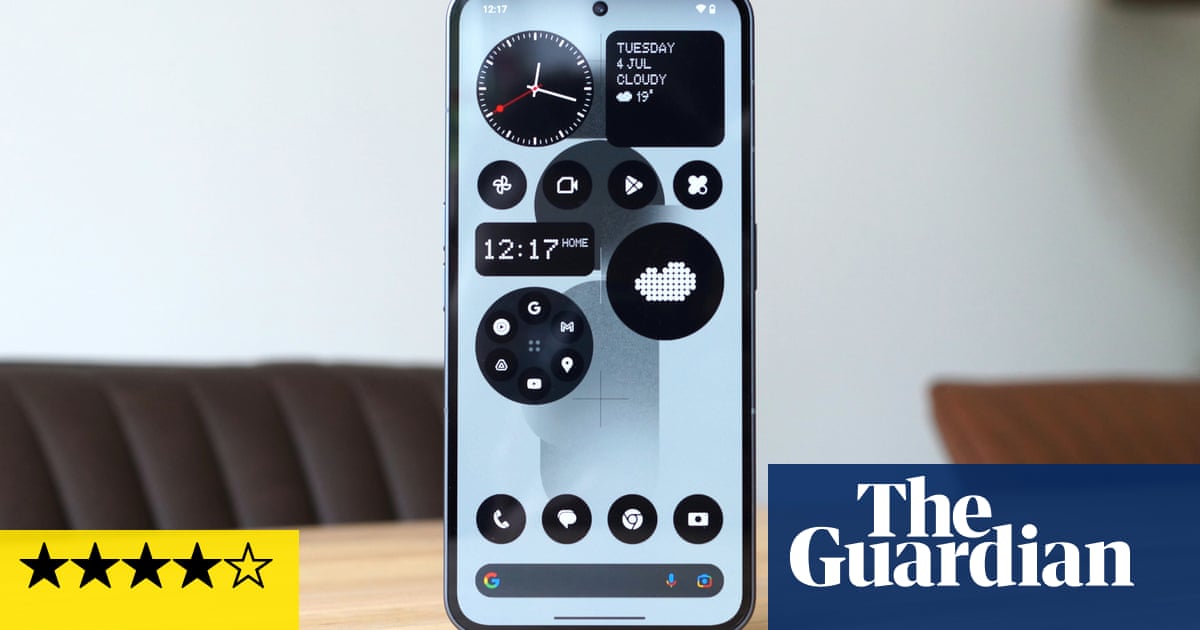
The Phone 2 is the latest Android smartphone from Nothing, a London-based company that specialises in good value devices with a novel transparent aesthetic.
Costing £579 ($599), it offers top-phone specs for a mid-range price. After the success of its first handset, the Phone 1 last year, Nothing has stuck with its unique design, which takes the classic metal and glass slab of most mobiles and livens them up with a transparent back that exposes a series of LED strips.
From the front it looks like most premium phones with a bright, good-looking and smooth 6.7in OLED screen. The aluminium sides are reminiscent of the iPhone 12, but the back glass has a gentle curve to it at the edges, which feels more premium compared with Phone 1.
The array of LEDs on the back can be used for more functions than on the Phone 1, and you are now able to adjust brightness automatically and light up in more complex patterns. One strip can be used as a visual countdown timer, another shows charge status and there is even the ability to show progress for activities in third-party apps, but this is now limited to rides in Uber.
You can set various flash patterns for different calls and notifications, with the ability to set them to light up continuously for your most important alerts. There are lots of ring and notification patterns included, but you can easily compose some yourself, which is fun.
The new device will go on sale in the US, as well as the UK and Europe – a first for the company.
Specifications
Screen: 6.7in 120Hz FHD+ OLED (394ppi)
Processor: Snapdragon 8+ Gen 1
RAM: 8 or 12GB
Storage: 128, 256 or 512GB
Operating system: Nothing OS 2.0 (Android 13)
Camera: 50MP main and ultrawide, 32MP selfie
Connectivity: 5G, eSIM, wifi 6, NFC, Bluetooth 5.3 and GNSS
Water resistance: IP54 (splash-resistant)
Dimensions: 162.1 x 76.4 x 8.6mm
Weight: 201.2g
Year-old but top-end chip
The Phone 2 has a Snapdragon 8+ Gen 1 chip, which is Qualcomm’s top model from last year but has since been replaced. That makes it slightly slower than this year’s fastest phones, but quicker than Google’s Pixel 7 and 80% faster than the Phone 1.
The phone is responsive and feels slick. Its battery life is solid, lasting a good 40 hours between charges including five hours of active screen use and four hours on 5G. That is longer than Google’s rival phones of a similar price, but you will still have to charge it every day and a half.
Sustainability
Nothing says the battery maintains at least 80% of its original capacity for at least 1,000 full charge cycles. The Phone 1 is generally repairable in the UK and the battery is replaceable for about £28 plus labour and shipping by Nothing.
The device is made of recycled aluminium, copper, plastic, steel, tin and other materials accounting for 20% of the phone’s weight. It has a carbon footprint of 53.45kg CO2 equivalent. The company publishes sustainability reports.
Nothing OS 2.0
Nothing’s take on Android 13 is an interesting mix of clutter-free software with some interesting quirks, compared with most phones.
It works like any other with gesture navigation, Google Feed and other standard Android bits. But Nothing has added options to make folders of apps bigger, with one-tap access to some of the apps within them. There are four folder designs to choose from including one with just a cover picture of an emoji. You can have standard small folders too, but the large almost widget-like folders are surprisingly fun and useful.
You can also put any of the quick settings that are usually in the notification shade as different-sized widgets on the home or lockscreen, which is equally useful. The phone has a theme that turns everything monochrome, including most third-party apps with a few red colour accents here and there.
Like the lights on the back of the phone, these little fun additions just add a bit of novelty to the very samey phone experience of competitors, but without fundamentally altering how Android works. Disappointingly, Nothing will only support the Phone 2 with three years of Android updates and four years of bimonthly security fixes from release, which is at least a year short of the best and is no longer up to standard.
Camera
The Phone 2 has a similar camera set up to the Phone 1 with two 50-megapixel cameras on the back and a 32MP selfie camera in the screen.
Images captured by all the cameras are generally improved over the phone’s predecessor. The main camera shoots good, well-balanced images in bright light as does the wide-angle camera. But as with the Phone 1, photos lack sharpness and detail when viewed at full size, with obvious blurring of moving objects and too much smoothing in more difficult lighting conditions.
The phone has no telephoto camera and the digital zoom leaves a lot to be desired. Video recording was solid for the money with a few fun features to play with including slo-mo up to 480 frames a second.
The Phone 2 produces generally good images but can’t compete with Google’s cheaper Pixel 7.
Price
The Nothing Phone 2 starts at £579 ($599) with 8GB of RAM and 128GB in store on 17 July.
For comparison, the Phone 1 costs £399, the OnePlus 11 costs £729, the Google Pixel 7 costs £499, the Samsung Galaxy S23+ costs £899 and the iPhone 14 Plus costs £949.
Verdict
The Phone 2 is a solid update on its predecessor but does not change the core formula of the device. It feels more premium while containing more recycled materials. It has more advanced lights, a significantly faster chip and solid battery life, while continuing to undercut much of the competition on price.
It is the novel design across the LED-strewn back and software that is the main draw. There is something very attractive about being a bit different without ruining usability.
The Phone 2 ships with an older chip than its rivals, which may not matter to most, and cannot match the competition on camera. But its biggest weakness is software support — four years of updates from release is simply not good enough anymore, losing it a star.
Pros: novel back and light design, great screen, good performance and battery life, recycled aluminium, slick Android 13 software, premium feel but competitively priced.
Cons: camera only so-so with no optical zoom, only four years of security updates, only splash-resistant, undercut by chief rival Google.












